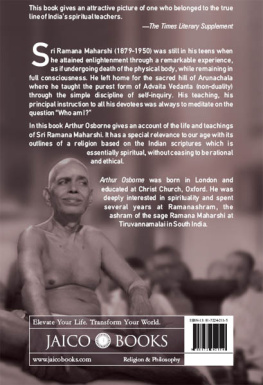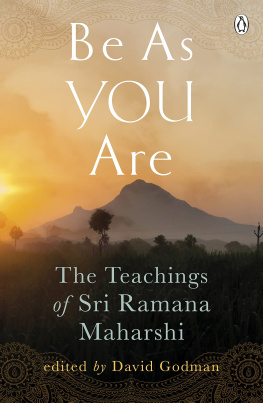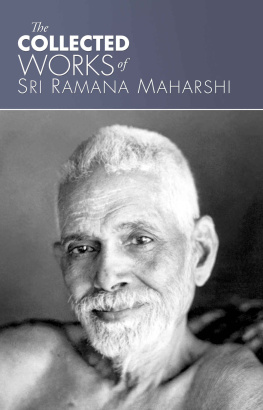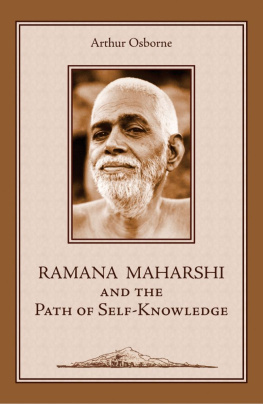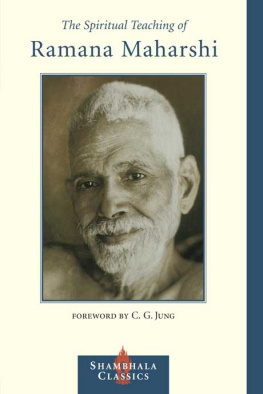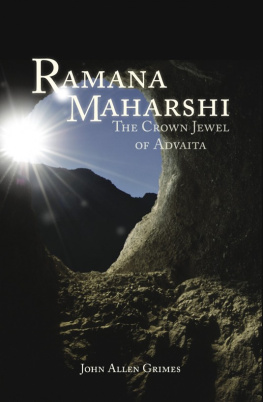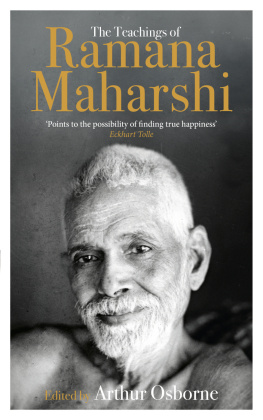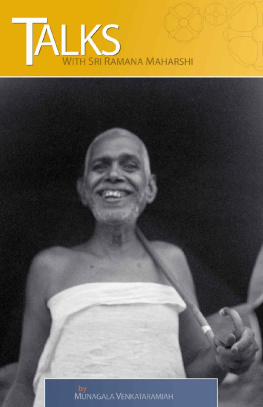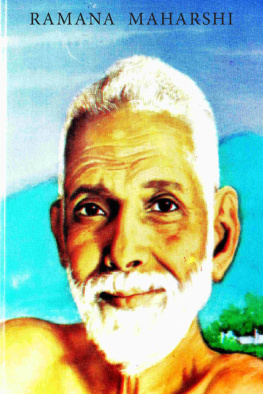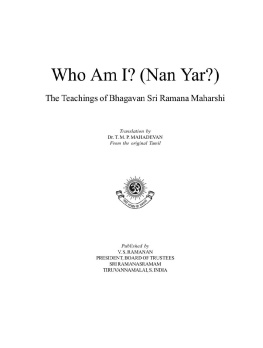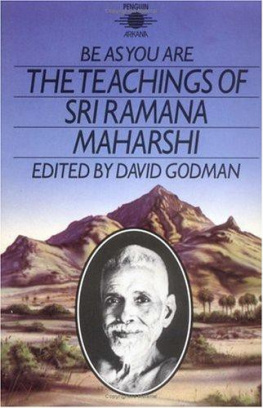Published by Jaico Publishing House
A-2 Jash Chambers, 7-A Sir Phirozshah Mehta Road
Fort, Mumbai 400 001
jaicopub@jaicobooks.com
www.jaicobooks.com
Sri Ramanasramam
THE MIND OF RAMANA MAHARSHI
ISBN 978-81-7224-211-5
First Jaico Impression: 1959
Twenty-first Jaico Impression (Enlarged edition): 2011
No part of this book may be reproduced or utilized in any form or by any means, electronic or mechanical including photocopying, recording or by any information storage and retrieval system, without permission in writing from the publishers.
CONTENTS
My gratitude is due to those older devotees who read through the manuscript of this book and made suggestions; and particularly to my wife, who helped enormously in the construction of the book.
Preface
In writing this book I have tried to make the meaning clear without using more foreign words than necessary. However, every language contains words which have no direct equivalent in another, and every science, spiritual as well as physical, has technical terms which scarcely admit of translation. Therefore it was necessary to use a certain number of Sanskrit and other words. These have been explained in the text, for easy reference and for an approximate idea of their pronunciation, a glossary has been added. Since it is intended to help the general reader in his understanding of the book. I have not given simple dictionary definition but rather an idea of the sense in which a word is used and of the doctrinal implications it carries.
Foreword
I am glad to write this short foreword to Mr. Osbornes account of the life and teaching of Sri Ramana Maharshi. It has a special relevance to our age with its dominant mood of wistful reluctant skepticism. We are given here a religion of the spirit which enables us to liberate ourselves from dogmas and superstitions, rituals and ceremonies and live as free spirits. The essence of all religion is an inner personal experience, an individual relationship with the Divine. It is not worship so much as a quest. It is a way of becoming, of liberation.
The well-known Greek aphorism Know thyself is akin to the Upanisad precept atmanam viddhi, know the self. By a process of abstraction we get behind the layers of body, mind and intellect and reach the Universal Self, the true light which lighteth every man that cometh into the world. To attain the Good, we must ascend to the highest state and fixing our gaze thereon, lay aside the garments we donned when descending here below; just as, in the Mysteries, those who are admitted to penetrate into the inner recesses of the sanctuary, after having purified themselves, lay aside every garment and advance stark naked. We sink into the measureless being that is without limitation or determination. It is pure being in which one thing is not opposed to another. There is no being to which the subject opposes himself. He identifies himself with all things and events as they happen. Reality fills the self as it is no longer barred by preferences or aversions, likes or dislikes. These can no more act as a distorting medium.
The child is much nearer the vision of the self. We must become as little children before we can enter into the realm of truth. This is why we are required to put aside the sophistication of the learned. The need for being born again is insisted on. It is said that the wisdom of babes is greater than that of scholars.
Sri Ramana Maharshi gives us the outlines of a religion based on the Indian Scriptures which is essentially spiritual, without ceasing to be rational and ethical.
S. RADHAKRISHNAN
Former President of India
Plotinus: Enneads, I, vi, 6.
Early Years

Arudra Darshan, the day of the Sight of Siva, is observed with great devotion by Saivites, for it commemorates the occasion when Siva manifested himself to his devotees as Nataraja, that is in the cosmic dance of creation and dissolution of the universe. On this day in 1879 it was still dusk when Sivas devotees in the little town of Tiruchuzhi in the Tamil land of South India left their houses and padded barefoot along the dusty road to the temple tank, for tradition demands that they should bathe at daybreak. The red glow of sunrise fell upon the brown torsos of the men, clad only in a dhoti, a white cotton cloth wrapped round the body from the waist down, and flashed in the deep reds and golds of the womens saris as they descended the stone steps of the large square tank and immersed themselves in the water. There was a nip in the air, for the festival fell in December, but they are hardy folk. Some few changed under trees or in houses near the tank but most waited for the rising sun to dry them and proceeded, dripping as they were, to the little towns ancient temple, hymned long ago by Sundaramurthi Swami, one of the sixty-three Saivite poet-saints of the Tamil land.
The image of Siva in the temple was garlanded with flowers and taken in procession throughout the day and night, with noise of drum and conch and chanting of sacred song. It was one oclock at night when the processions ended, but still Arudra Darshan because the Hindu day stretches from dawn to dawn, not from midnight to midnight. The idol of Siva re-entered the temple just as the child Venkataramana, in whom Siva was to be manifested as Sri Ramana, entered the world in the house of Sundaram Ayyar and his wife Alagammal. A Hindu festival varies with the phase of the moon, like the Western Easter, and in this year Arudra Darshan fell on December 29th, so that the child was born a little later, both in time of day and year, than the divine child of Bethlehem nearly two thousand years before. The same coincidence marked the end of earthly life also, for Sri Ramana left his body on the evening of April 14th, a little later in time and date than Good Friday afternoon. Both times are profoundly appropriate. Midnight and the winter solstice are the time when the sun is beginning to bring back light to the world, and at the spring equinox day has equaled night and is beginning to exceed it.
After starting life as an accountants clerk on the salary, ridiculously small even for those days, of two rupees a month, Sundaram Ayyar had set up for himself as a petition writer and then, after some years, obtained permission to practice as an uncertified pleader, that is a sort of rural lawyer. He had prospered and had built the house in which the child was born, making it commodious enough for one side to be reserved for guests. It was not only that he was sociable and hospitable, but also because he took it on himself to house official visitors and newcomers to the townwhich made him a person of civic importance and doubtless reacted favourably on his professional work.
Successful as he was, a strange destiny overhung the family. It is said that a wandering ascetic once stopped to beg food at the house of one of their forebears and, on being refused, turned on him and pronounced that thenceforth one out of every generation of his descendants would wander and beg his food. Curse or blessing, the pronouncement was fulfilled. One of Sundaram Ayyars paternal uncles had donned the ochre robe and left home with staff and water-pot; his elder brother had gone ostensibly to visit a neighbouring place and from there slipped away as a

